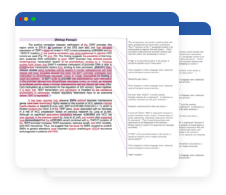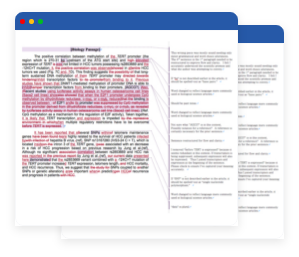Adverbs and Adverbials
An adverb is a word that describes a verb, an adjective, another adverb, or an entire sentence. Adverbs are usually single words that often end in -ly, and in many cases, adverbs are constructed by adding -ly to the adjective counterparts (e.g., beautiful → beautifully).
Adverbs can be used to describe how something is done or to tell how many or how much of something there is. Using adverbs can be helpful to provide a more detailed description in a sentence.
There are five types of adverbs: time, manner, degree, place, and frequency. The adverbs in each of the five categories are used in sentences to describe when, how, to what extent, where, and how often something is done.
Types of adverbs
| Adverb type | What it does | Adverb examples |
|---|---|---|
| Adverb of time |
Provides information about when a verb takes place |
never, lately, just, always, recently, during, yet, soon, sometimes, usually, so far |
| Adverb of manner |
Provides information about how a verb is done |
carefully, softly, slowly, quickly, sadly, calmly, politely, loudly, kindly, lazily |
| Adverb of degree |
Provides information about the level or intensity of a verb, adjective or another adverb |
almost, quite, nearly, too, enough, just, hardly, simply, so |
| Adverb of place |
Provides information about where a verb takes place |
here, there, nowhere, everywhere, out, in, above, below, inside, outside, into |
| Adverb of frequency |
Provides information about how often a verb is done |
never, always, rarely, sometimes, normally, seldom, usually, again |
Using Adverbs with Verbs
Adverbs modify verbs to describe how the action is happening. An adverb usually comes right before or after the verb it modifies.
- Example
- He runs quickly to get to school.
The adverb, quickly, is used to describe how he ran.
- Example
- She carefully took out a book from the shelf.
The adverb “carefully” is used to describe how she took out a book.
Both adverbs in the two sentences above, “quickly” and “carefully,” describe how the action was performed. How did he run? How did she take out a book?
Using Adverbs with Adjectives
Adverbs modify adjectives to modify the level of intensity of the adjectives.
- Example
- I will be slightly late to the party.
The adverb, slightly, is used to modify how late I will be to the party.
- Example
- You've done a pretty good job.
The adverb “pretty” is used to modify how well you have done the job. Both adverbs in the two sentences above, “slightly” and “pretty,” modify the adjectives to describe the extent of how something was done.
Using Adverbs with Other Adverbs
Adverbs modify other adverbs to intensify the adverbs. Most of the time, an adverb that modifies another adverb should be placed right before the adverb it modifies.
- Example
- She finished the job extremely quickly.
The adverb “extremely” is used to modify another adverb “quickly.”
- Example
- Don't drive your car so fast.
The adverb “so” is used to modify another adverb, “fast.” Both adverbs in the two sentences above, “extremely” and “so,” modify the adverbs placed right next to them to describe the extent of the adverbs they modify.
Adverbial Phrases
An adverbial phrase is a group of words that function as an adverb. While an adverb is a single word in many cases, an adverbial phrase consists of more than one word to add more information to a verb, adjective, another adverb, or an entire sentence. An adverbial phrase can function as an adverb even without containing an adverb in the group of words. Adverbial phrases often contain a preposition.
- Adverb
- I will sit here silently.
- Adverbial Phrase
- I will stay here in silence.
- Adverb
- She will drop by later.
- Adverbial Phrase
- She will drop by when she gets off from work.
- Example
- I went to the store to get some groceries.
In this sentence, the adverbial phrase “to get some groceries” is used to describe the purpose of going to the store.
- Example
- He parked his car over there near the park.
In this sentence, the adverbial phrase “over there near the park” is used to describe the place where he parked his car.
Showing Degrees of Comparison
Adverb forms can be changed to show degrees of comparison just as adjective forms are changed (busy, busier, busiest).
Flat adverbs
An adverb that looks the same as its adjective counterpart is called a flat adverb. For a flat adverb, the comparative and superlative forms look the same as the comparative and superlative forms of its adjective counterpart.
| Absolute Adverb | Comparative Adverb | Superlative Adverb |
|---|---|---|
|
fast |
faster |
fastest |
|
close |
closer |
closest |
|
hard |
harder |
hardest |
|
free |
freer |
freest |
|
right |
righter |
rightest |
Adverbs that ends in -ly
For comparative and superlative forms of adverbs that end in “-ly,” the words more and most are used.
| Absolute Adverb | Comparative Adverb | Superlative Adverb |
|---|---|---|
|
brightly |
more brightly |
most brightly |
|
clearly |
more clearly |
most clearly |
|
seriously |
more seriously |
most seriously |
|
faithfully |
more faithfully |
most faithfully |
|
promptly |
more promptly |
most promptly |
One-syllable adverbs
For the comparative form of a one-syllable adverb, -er is placed at the end of the root verb form. For the superlative form, -est is used.
| Absolute Adverb | Comparative Adverb | Superlative Adverb |
|---|---|---|
|
long |
longer |
longest |
|
high |
higher |
highest |
|
near |
nearer |
nearest |
|
early |
earlier |
earliest |
|
wide |
wider |
widest |
Irregular adverb forms
There are also irregular comparative and superlative forms of adverbs.
| Absolute Adverb | Comparative Adverb | Superlative Adverb |
|---|---|---|
|
well |
better |
best |
|
bad |
worse |
worst |
|
much |
more |
most |
|
far |
farther |
farthest |
Adverb Placement
Generally, adverbs should be placed right before or after (or as close as possible) to the words they are supposed to modify.
There are three places where an adverb can be placed:
1)At the very beginning of a sentence
2)Before the main verb
3)After the main verb or at the end of a sentence
In many cases, an adverb can be placed in either of the three places, and it may not affect the meaning of the sentence.
- Example
-
Quickly, she disappeared into the crowd.
She quickly disappeared into the crowd.
She disappeared into the crowd quickly.
- Example
-
Cheerfully, I said goodbye to my friend.
I cheerfully said goodbye to my friend.
I said goodbye to my friend cheerfully.
Regardless of where the adverbs “quickly” and “cheerfully” are placed, the meaning of all the sentences remains the same. In this case, the placement of the adverb is merely a stylistic choice.
However, in other cases, misplacing the adverbs can completely change the meaning.
- Example
-
I only want to go to the mall.
I want to go to the mall only.
These two sentences have two different meanings. The first sentence means “All I want to do is go to the mall,” and the second sentence means “The only place I want to go is the mall.”
- Example
-
Especially, you should treat her nicely.
You should especially treat her nicely.
You should treat her especially nicely.
In the first sentence, the adverb “especially” emphasizes the subject “you,” while in the second sentence, the adverb emphasizes the fact that it is her that should be treated nicely. In the third sentence, “especially” modifies the adverb “nicely.”
Because of these potentially ambiguous meanings, it is best to place the adverb right next to the verb it is modifying.
Placing adverbs with intransitive verbs
When an adverb is used with an intransitive verb, in some cases the adverb is placed after the intransitive verb to avoid making the sentence sound awkward.
- Awkward
- He softly spoke.
- Correct
- He spoke softly.
- Awkward
- The children loudly laughed.
- Correct
- The children laughed loudly.
However, for adverbs of frequency such as never, always, often, rarely, and seldom, the adverbs should always be placed before the intransitive verb.
- Incorrect
- You should come always home after school.
- Correct
- You should always come home after school.
- Incorrect
- He calls rarely me.
- Correct
- He rarely calls me.
Common Adverb Mistakes
Adverbs indicating frequency usually go before the main verb.
- Incorrect
- She cleans hardly ever her room.
- Correct
- She hardly ever cleans her room.
- Incorrect
- I take a bath always after dinner.
- Correct
- I always take a bath after dinner.
Adverbs indicating manner usually go at the very end of the sentence.
- Incorrect
- She loudly spoke.
- Correct
- She spoke loudly.
- Incorrect
- He folded neatly his shirt.
- Correct
- He folded his shirt neatly.
The adverb enough always goes after the verb it modifies.
- Incorrect
- This bag is enough big.
- Correct
- This bag is big enough.
- Incorrect
- I'm not enough strong to do this.
- Correct
- I'm not strong enough to do this.
Good vs Well
“Good” is an adjective and “well” is an adverb. However, these two words are often misused in many cases.
- Incorrect
- I play the piano good.
- Correct
- I play the piano well.
- Incorrect
- She speaks English good.
- Correct
- She speaks English well.
In academic writing, it is better to avoid using adverbs since they can cause ambiguity and increase word count. Instead of using adverbs, apply one-word verbs that are more powerful and precise.










